1.3 Evaluating the sources of information you use
4 min read•june 18, 2024
Zaina Siddiqi
AP Research 🔍
28 resourcesSee Units
Are you ready to research?! (This is the fun part!!) 😋
So, now that we have an idea of what we want to research, let's start gathering information and creating a plan!
Here are some strategies to gather your information:
🥳 Start with primary and secondary sources
Primary Source-a piece of evidence or information that comes directly from the original source, such as a document or artifact created during the time period under study. Examples of primary sources include letters, diaries, photographs, newspaper articles, government documents, and works of art. They provide a first-hand account of an event, idea, or time period, and are considered to be more reliable and valuable than secondary sources.
Some indications that a source is primary include:
- The source is a firsthand account or original document, such as a diary entry, a letter, or a photograph, created by someone who was present at the time of the event
- The source is a scientific study or experiment that reports the original data and findings of the researcher
- The source is a work of literature, art, or music that was created during the time period being studied
- The source is an artifact or object from the time period being studied
- The source is a government document, such as a census or legislative record, created at the time of the event.
Secondary Source-a piece of evidence or information that is based on one or more primary sources. It provides an analysis, interpretation, or summary of the primary sources, and is typically created after the time period under study. Examples of secondary sources include textbooks, biographies, history books, critical essays, and documentaries.
Some indications that a source is secondary include:
- The source is an interpretation or analysis of primary sources, such as a history book or a biography
- The source is a work that was written or produced after the time period being studied, such as a modern historical analysis
- The source is a review or critique of a primary source, such as a book or movie review
- The source is a work that synthesizes or summarizes multiple primary sources
- The source is a research paper, article or essay that cite and draw from primary sources, but it's not the original research.
You get a FREE EBSCO subscription with your purchase of the AP Research exam, found through the College Board AP Classroom website. USE YOUR RESOURCES!!! EBSCO is an extremely reliable database and most sources from there will be well-qualified for your research.
Bibliography
🥳 When looking at studies, check out their bibliographies! You may find related sources rich with information.

Boolean Operators
🥳 When looking for studies, use boolean operators to refine your search on databases like EBSCO or JSTOR.

Image courtesy of Aaron Tay's Musings about librarianship
When gathering data, social media may not be the best for research, unless you're analyzing syntax from social media.
When citing sources, you may use a site like EasyBib HOWEVER their citations often have minor issues. I recommend using PurdueOwl and figuring out what citation style is best for your paper. Historical? MLA. Scientific? APA.
If you're conducting a behavioral study and need participants in order to collect your data, sites like GoogleForms and SurveyMonkey will be your best friend.
Gather and organize your information
If you have a hypothesis, what supports/does not support it? You may also find peer-reviewed research similar to your research question and model a similar experiment after it.
💭 Here's an example:
a study on the effectiveness of cognitive-behavioral therapy (CBT) in treating depression. The study, published in the Journal of Consulting and Clinical Psychology, recruited participants who had been diagnosed with major depressive disorder and randomly assigned them to receive either CBT or a placebo treatment. The researchers then evaluated the participants' symptoms of depression before and after treatment, and found that those who received CBT had significantly greater reductions in their symptoms than those who received the placebo.
If you are interested in conducting a similar experiment, you could consider recruiting participants who have been diagnosed with depression, randomly assigning them to receive either CBT or a placebo treatment, and then evaluating their symptoms of depression before and after treatment. However, it is important to note that you should always conduct a thorough literature review and seek out ethical and regulatory approvals before conducting any research.
So... that was a lot. But come back and refer to these tips as you progress, I promise it'll be helpful at every step of the way. GOOD LUCK! 😊
Browse Study Guides By Unit
🤨Unit 1 – Question & Explore
🔎Unit 2 – Understand & Analyze
👥Unit 3 – Evaluate Multiple Perspectives
💡Unit 4 – Synthesize Ideas
🗣Unit 5 – Team, Transform, & Transmit
🎓The Academic Paper
✏️Frequently Asked Questions
📚Study Tools

Fiveable
Resources
© 2025 Fiveable Inc. All rights reserved.